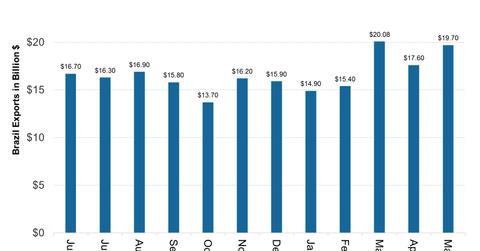Did Brazil’s Exports Surge in May 2017 Due to Improved Global Demand?
In the first five months in 2017, the Brazil’s exports rose 18.5% to $87.9 billion compared to the same period in 2016.
June 28 2017, Updated 10:36 a.m. ET

Exports in Brazil
Brazilian (EWZ) exports jumped in May 2017 as they recovered from a decline in April 2017, with external factors supporting improved demand conditions. Currently, Brazil (BRZU) is facing some severe domestic issues concerning political corruption and high levels of unemployment.
This political instability has led to the declining performance of Brazilian assets, including stocks (BZQ) and the Brazilian real (BZF). However, the depreciation in the real is expected to help its exports in the short term in 2017. Let’s look at Brazil’s exports over the last year in the chart below.
Exports in May 2017
Brazil’s (UBR) exports stood at $19 billion in May 2017, an increase of ~12% compared to a decline of 12% in April 2017. The country’s exports grew 12.6% year-over-year to $19.7 billion in May 2017. These exports were mainly boosted by sales of semi-manufactured products such as iron and steel, sugar, pulp, sawn wood, and leather.
The basic products category also saw an increase in exports, primarily in corn, crude oil, copper, iron ore, coffee beans, and soybeans. However, exports of manufactured products fell 1.2%, specifically in electric motors and generators as well as plastic polymers.
In the first five months in 2017, the country’s exports rose 18.5% to $87.9 billion compared to the same period in 2016. The higher prices in 1Q17 for iron ore, oil, soy, cargo vehicles, and automobiles improved the total value of exports in the first five months of 2017.
The commodity and oil price surges since 2016 seem to be helping the country’s exports in 2017. However, in the last two months, oil and commodities prices have declined, which could impact the exports of commodity-dependent countries in 2017.
Let’s look at the business confidence in Brazil in our next article.
